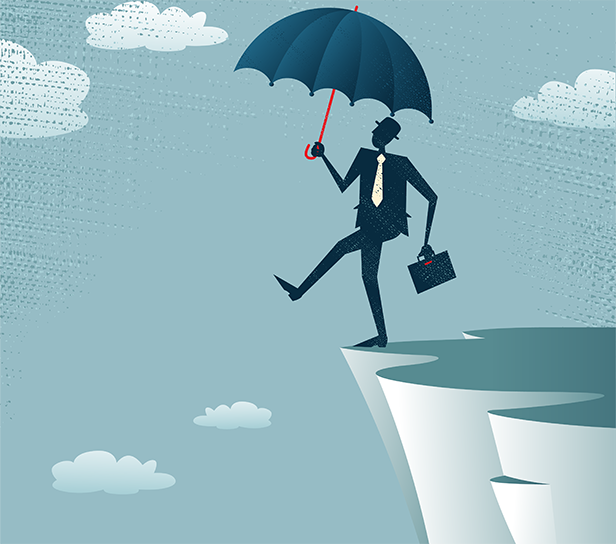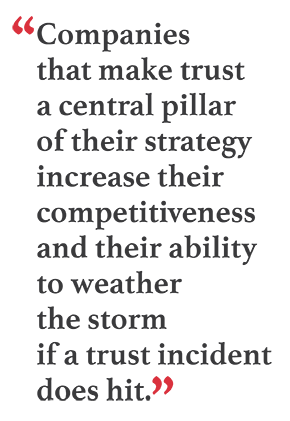
From reports of tainted food and product recalls to cyber breaches resulting in theft of consumer data, incidents that reduce customers' trust in businesses are becoming increasingly visible to the general public. That makes trust-related risks a fast-growing area of vulnerability that could threaten companies' ability to compete. Consider, for example, how a highly publicized product defect that harms consumers might affect a business's long-term success.
The heightened transparency of our digital world makes trust a hyper-flammable, ever-present concern that extends far beyond media headlines and brief dips in reputation. Instead, an incident that compromises the trust of key stakeholders can have a significant and lasting impact on a company's bottom line.
In Accenture Strategy's new research report on companies' competitive agility, called “The Bottom Line on Trust,” we calculate the extent to which a decline in trust tangibly impacts a company's financial performance. The results are astounding. We analyzed more than 7,000 companies around the world, operating across 20 industries, and we found that more than half of those organizations had experienced a major drop in trust during the past two and a half years. Moreover, we determined, based on available data, that as a result of these lapses in trust, the companies missed out on a combined total of at least US$180 billion in potential revenue.
Over the course of this study, we realized that industry disruption, emerging markets, and the ever-increasing pace of technological change are preventing traditional performance gauges, like market capitalization or total shareholder return, from painting the full picture of companies' future competitiveness. To address this need, Accenture Strategy developed a new metric: the Competitive Agility Index.
Based on a company's strategies for growth, profitability, sustainability, and trust, the Competitive Agility Index reflects how an organization is positioned to compete against its peers amid the growing complexities of the Digital Age. We determined correlations among the factors driving competitive agility by using publicly available data, as well as sustainability and trust metrics. We worked with our partner Arabesque to create a proprietary trust metric, based on Arabesque's S-Ray sustainability score, that measures the perceived level of trust among key stakeholder groups. From this data, we then calculated a Competitive Agility Index score to quantify each company's competitiveness.
 Our analysis found that when a company faces a material loss of trust among stakeholders—customers, employees, investors, suppliers, analysts, and the media—that company's Competitive Agility Index score typically falls by two points. This equates to reducing the rate of revenue growth by 6 percent and reducing growth in earnings before interest, taxes, depreciation, or amortization (EBITDA) by 10 percent, on average.
Our analysis found that when a company faces a material loss of trust among stakeholders—customers, employees, investors, suppliers, analysts, and the media—that company's Competitive Agility Index score typically falls by two points. This equates to reducing the rate of revenue growth by 6 percent and reducing growth in earnings before interest, taxes, depreciation, or amortization (EBITDA) by 10 percent, on average.
As the intrinsic link between trust and financial performance becomes increasingly clear, organizations are understanding that trust is a non-negotiable necessity. Our study revealed another trend that underscores the importance of this attitude. In our study, the companies whose overall Competitive Agility Index scores fell the farthest were the same businesses that experienced a reduction in trust. Although trust accounts for roughly 6 percent of a company's total score in our calculations, its add-on impacts to revenue and EBITDA compound its effect on long-term competitiveness.
This makes it even more alarming that more than half the companies we evaluated experienced a significant reduction in trust during our study period. Trust is becoming increasingly difficult to build and maintain, and companies must do more to preserve it. For each business, the answer to the trust crisis lies not in its response to a specific incident, but in its fundamental mission and approach to stakeholder relationships. To compete in today's digital world, an organization must weave trust into the fabric of its DNA, strategy, and day-to-day operations. Nothing is more fundamental to building a healthy business than convincing all stakeholders that the organization they are dealing with is transparent and trustworthy, takes demonstrated action to fulfill its commitments and promises, and fully embodies their values. In essence, stakeholder trust gives companies a license to operate and to grow.
In this age of transparency, how a company does things has become just as important as what it does.
No Industry Is Immune
Trust events don't discriminate. All types of companies are susceptible to the potential financial and reputational ramifications. Still, some industries are more vulnerable than others. Within each sector, the level of competition among companies and the importance of brand or reputation in customers' purchase decisions help determine how much impact a drop in an organization's trust score will have on its Competitive Agility Index score.
According to our study, companies in the banking and retail sectors are most at risk of drops in revenue growth following a loss of trust. For example, we determined that a $30 billion retail company experiencing a material drop in trust stands to lose $4 billion in future revenue. These two real-world examples make clear the intertwined relationship between trust and bottom-line competitiveness:
- A sustainability backfire. One business-to-consumer (B2C) company that we evaluated launched a sustainability-oriented publicity event that backfired when event organizers failed to consult with environmental experts. The result was broken trust with the organization's stakeholders. Negative viral publicity hammered the company's trust score, causing it to fall by 8 percent in one quarter. The organization's Competitive Agility Index score for the year then fell by 1.4 percent. Its revenue declined by $400 million, while EBITDA dropped $200 million.
- A $1 billion blunder. When a business-to-business (B2B) company was named in a money laundering allegation, its trust score dropped 9 percent in just one quarter. Revenue in the following year fell almost 34 percent, or $1 billion, with EBITDA diving around 61 percent, by $700 million.
Trust is critical to a company's bottom line. C-suite leaders who downplay it do so at their own risk. Managing and measuring trust as part of corporate strategy have become table stakes to revenue growth and even long-term survival.
The New Face of Competitiveness
The findings of our study underscore another key reality: Definitions of competitiveness are evolving rapidly. As industries are disrupted, new markets emerge, and the pace of technological change barrels on, companies can no longer rely solely on traditional gauges like market cap or total shareholder return to fully understand their competitiveness. These measures reveal just one piece of the organization's competitiveness picture. They may effectively estimate business performance or current valuation at a static point in time, but they are less indicative of how well a company is poised to compete in the future.
Executives need new approaches for assessing their business's future competitiveness. They need key performance indicators (KPIs) that take into account the unprecedented transparency of business operations across most industries, the real-time digital distribution of news to all types of stakeholders, the potential impact of sustainability concerns, and the evolving opinions of increasingly value-conscious and scrutinizing stakeholders.
These stakeholders' interactions with and impressions of the business (and its competitors) drive their purchasing, engagement, and investment decisions every day. Today's customers have more choices than ever before, and they're looking to affirm their own values when choosing which organizations they do business with. Employee trust is crucial in the war for talent, as a company's reputation and actions become ever more important to job seekers. Suppliers and trusted partners are key players in today's business value chain. And analysts and investors are increasingly interested in not just financial performance, but also a more holistic view of performance (e.g., environmental or social-impact metrics).
The companies that are best prepared for future success are strong not just in revenue growth and profitability, but also in sustainability and trust—factors that will drive revenue and profitability in years to come. Our study proves that a balanced strategy—one that puts sustainability and trust on equal footing with financial factors—positions a company for success better than any strategy focused on only one or two of these pillars.
To effectively incorporate trust into strategy and operations, a business needs to:
- Routinely measure trust and sustainability, as well as profitability and growth. Companies must understand where they stand on trust and competitiveness, and the only way to know is to measure. We developed the Competitive Agility Index to provide a more holistic view of corporate success. It's one option—but whether an organization chooses the Competitive Agility Index or another performance indicator, monitoring how the business is perceived by key stakeholders is crucial in maintaining trust and developing an informed competitiveness strategy.
- Walk the talk when it comes to trust. A company's leadership team must embrace trust as a core element of business strategy and ensure this mind-set is engrained in the organizational structure from the top down. Employees at every level and in every department must make trust the bedrock of their decision-making. They must take deliberative actions designed to cultivate trust with stakeholders through ethical choices, transparency, and follow-through on commitments.
- Ensure trust is a key element in overall corporate strategy. When companies make choices that sacrifice long-term values in order to deliver near-term cost savings and profit improvement, they may be unaware of how their behavior could undermine trust. But if their actions do have a trust impact, they risk undermining financial performance in the long term. Across every aspect of strategy, a business needs to work to improve trust across all of its stakeholders. Doing so helps the company access new avenues to growth and protect its bottom line.
In our changing—and increasingly transparent—business climate, trust is intrinsically tied to a company's bottom line. Mishandling this asset can negatively, and at times irreversibly, impact growth and profitability. Companies that make trust a central pillar of their strategy increase their competitiveness and their ability to weather the storm if a trust incident does hit. Those that don't adequately emphasize this “soft” asset are ultimately putting billions in future revenue at risk.
 Christopher Roark is managing director for Accenture Strategy; he is responsible for leading Accenture Strategy's competitiveness and zero-based cost management platforms in North America. Roark has spent more than two decades working with publicly traded and privately held consumer-oriented companies to drive enterprise value through growth strategies, operating model designs, and structural cost resets. He is based in Chicago.
Christopher Roark is managing director for Accenture Strategy; he is responsible for leading Accenture Strategy's competitiveness and zero-based cost management platforms in North America. Roark has spent more than two decades working with publicly traded and privately held consumer-oriented companies to drive enterprise value through growth strategies, operating model designs, and structural cost resets. He is based in Chicago.
© Touchpoint Markets, All Rights Reserved. Request academic re-use from www.copyright.com. All other uses, submit a request to [email protected]. For more inforrmation visit Asset & Logo Licensing.


